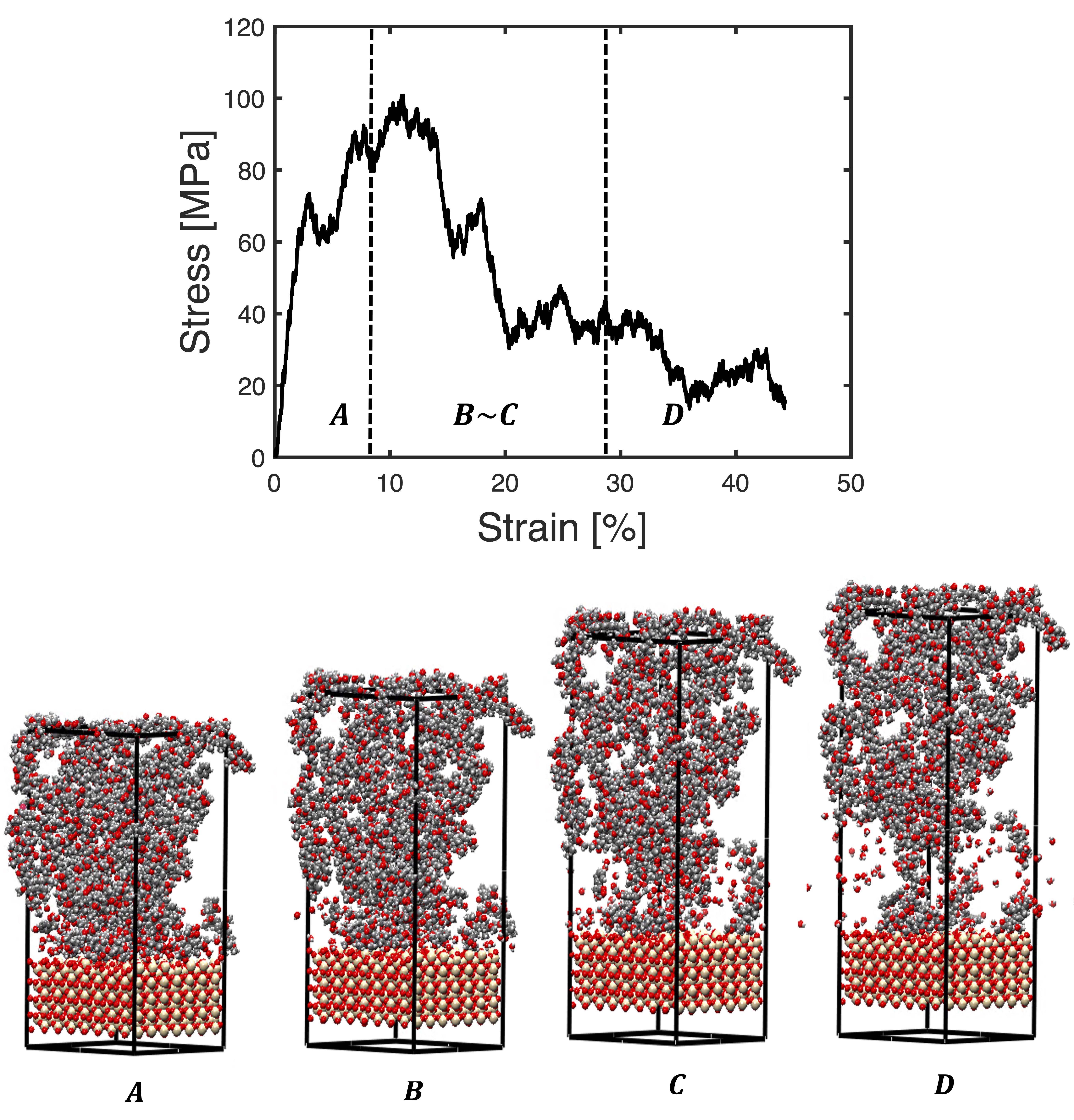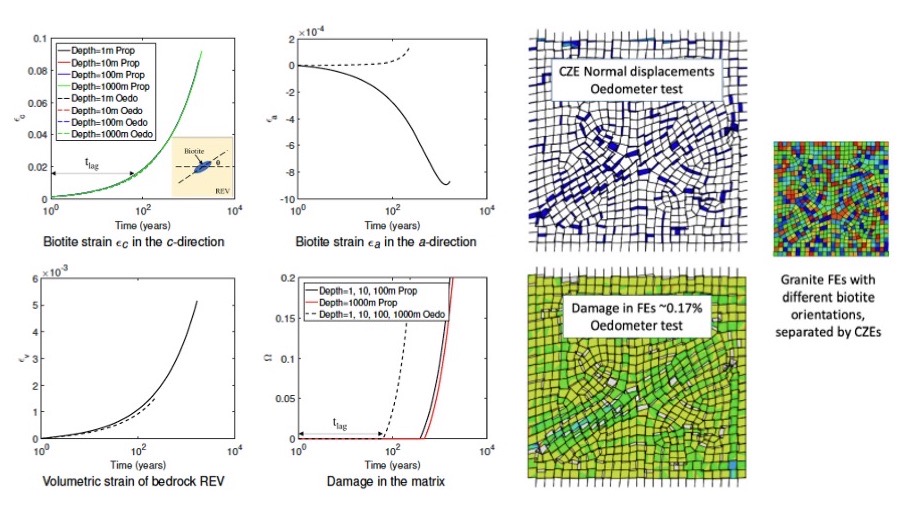
DeeP MeLT
Arson's Lab
Computational geomechanics applied to engineering and science
Geological storage, structural engineering, material sciences, geomeorphology
We have applied damage and healing models to solve problems of geotechnical engineering and Earth science that had long remained open issues. For instance, we proposed a Mori-Tanaka homogenization scheme to model granite bedrock weakening, a phenomenon of primary importance to understand how soil forms and to trace the history of climate on Earth. Simulations showed that, at the typical depth of bedrock fractured zones, weathering controls micro-crack propagation over regional stresses, hence the formation of saprolite, which then degrades into soil. Moreover, we implemented a micro-macro model of pressure solution in the Finite Element Method (FEM) to assess the feasibility of self-healing geological storage facilities in salt rock. Thermo-hydro-mechanical models formulated were used to study the effect of suction on damage propagation around nuclear waste disposals in clay stone. Damage-induced anisotropy in sedimentary rocks was simulated for petroleum engineering applications. We also used Molecular Dynamics (MD) to optimize the strength of concrete/epoxy interface and provide reinforced concrete reparation recommendations to the Georgia Department of Transportation.
- C. O’Sullivan, C. Arson, B. Coasne, 2022. A perspective on Darcy’s law across the scales: from physical foundations to particulate mechanics, Journal of Engineering Mechanics, DOI: 10.1061/(ASCE)EM.1943-7889.0002153
- S.V. Bokkisa, J. Macedo, A. Petalas, C. Arson, 2022. Assessing flow liquefaction triggering considering fabric anisotropy effects under the ACST framework, Computers and Geotechnics, DOI: 10.1016/j.compgeo.2022.104796
- K. Ji, L. Stewart, C. Arson, 2022. Molecular Dynamics analysis of silica/PMMA interface shear behavior, Polymers, DOI: 10.3390/polym14051039
- K. Ji, N. Gao, P. Wang, L. Stewart, C. Arson, 2021. Finite Element model of concrete repaired by High Molecular Weight Methacrylate (HMWM), Engineering Structures, 10.1016/j.engstruct.2021.111860.
- K. Ji, C. Arson, 2020. Tensile strength of calcite/HMWM and silica/HMWM interfaces: A Molecular Dynamics analysis, Construction and Building Materials, DOI:10.1016/j.conbuildmat.2020.118925.
- X. Shen, C. Arson, 2019. Simulation of salt cavity healing based on a micro-macro model of pressure-solution, Petroleum Geoscience, DOI: 10.1144/petgeo2018-094.
- W. Jin, C. Arson, 2018. Micromechanics based discrete damage model with multiple non-smooth yield surfaces: theoretical formulation, numerical implementation and engineering applications, International Journal of Damage Mechanics, DOI: 10.1177/1056789517695872
- R. Kirkman, C. Arson, L. Stewart, R. Harris, A. Francis, 2017. The risks of hydraulic fracturing and the responsibilities of engineers, Elementa: Science of the Anthropocene, DOI: 10.1525/elementa.218.
- H. Xu, S. Busetti, C. Arson, 2017. Fracture-Induced Anisotropy of the Stress-Strain Response of Shale at Multiple Scales, ASCE International Journal of Geomechanics, DOI: 10.1061/(ASCE)GM.1943-5622.0000897
- M. Sanchez, C. Arson, A. Gens, F. Aponte, 2016. Analysis of Unsaturated Materials Hydration Incorporating the Effect of Thermo-Osmotic Flow, Geomechanics for Energy and the Environment, DOI: 10.1016/j.gete.2016.05.001
- C. Zhu, A. Pouya, C. Arson, 2015. Micro-macro analysis and phenomenological modeling of salt viscous damage and application to salt caverns, Rock Mechanics and Rock Engineering, DOI: 10.1007/s00603-015-0832-9.
- H. Xu, C. Arson, 2015. Mechanistic Analysis of Rock Damage Anisotropy and Rotation around Circular Cavities, Rock Mechanics and Rock Engineering, DOI: 10.1007/s00603-014-0707-5.
- T. Ozudogru, G. Olgun, C. Arson, 2015. Analysis of friction-induced thermo-mechanical stresses on a heat exchanger pile in isothermal soil, Geotechnical and Geological Engineering, DOI: 10.1007/s10706-014-9821-0.
Finite Element simulation of geological storage
A self-consistent inclusion-matrix model was formulated to homogenize the viscoplastic deformation of halite polycrystals and predict the number of broken grains in a Representative Elementary Volume of salt. This micro-macro modeling framework was used to simulate creep tests under various axial stresses and calculate the critical viscoplastic strain at which grain breakage is expected to occur. We used the critical viscoplastic deformation as a yield criterion to control the transition between secondary and tertiary creep in a phenomenological viscoplastic model implemented in a Finite Element Method program. Simulations of cavern depressurization indicate that a strain-dependent damage evolution law is more suitable than a stress-dependent damage evolution law, because it avoids high damage concentrations and allows capturing the formation of a damaged zone around the cavity.
Next, we simulated carbon dioxide storage in salt rock, assuming constant gas pressure. The initial state is determined by simulating cavity excavation with a Continuum Damage Mechanics (CDM) model. Storage was simulated by using a micro macro healing mechanics model. FEM simulations show that independent of salt diffusion properties, healing is limited by stress redistributions that occur around the cavity during pressure solution. In standard geological storage conditions, the displacements of the cavity occur within the five first days of storage and the damage is reduced by only 2%.

Pictures: Zhu, Pouya and Arson (2015); Shen and Arson (2019)
Multiscale model of fracture propagation in repaired concrete
Although epoxy is widely used to repair cracks that are less than a millimeter in width, the mechanical behavior of epoxy-repaired concrete remains vastly unknown. Here, we provide a quantitative assessment of concrete repaired by injection of High Molecular Weight Metacrylate (HMWM). Uniaxial compression tests and three-point bending tests were conducted on cut-and-repaired specimens. The experiments were simulated with the Finite Element Method (FEM), in which concrete was assigned a constitutive model that combines continuum damage mechanics and plasticity and in which the concrete/HMWM interface was modeled with bilinear softening cohesive zone elements (CZEs). The numerical model was calibrated and validated against the experimental results. Steel-reinforced concrete (RC) beams were subjected to three-point bending to produce cracks. The beams were then repaired and reloaded. We used Digital Image Correlation (DIC) to identify the zones of high maximum principal strain after the first loading cycle. These zones were modeled with repaired concrete elements and HMWM CZEs to simulate the second load cycle. The load-displacement curves, damage distributions and strain fields obtained numerically are in agreement with those obtained experimentally, which validates the proposed model. Our simulation results suggest that HMWM can penetrate cracks of width 0.01 mm and above by gravity. We also found that HMWM reparation increases concrete stiffness and strength if crack in concrete members are over 0.1 mm in width, in which case, the load capacity of repaired RC beams is 30 to 40% higher than that of as-built RC beams.

Pictures: Ji, Gao, Wang, Stewart, Arson, 2020
Molecular Dynamics (MD) model of concrete/epoxy interface behavior
The mechanical behavior of interfaces between high molecular weight methacrylate (HMWM) and concrete minerals (calcite and silica) is investigated from a Molecular Dynamics (MD) perspective. MD simulations of pullout tests shows that interfaces debond at the surface of contact between HMWM and the mineral substrate, and that the interfacial strength decreases in the presence of moisture, under low strain rate, or at high temperature. Silica/HMWM interfaces are stronger than the calcite/HMWM interfaces. Additionally, the work of separation is mostly done by van der Waals forces, in agreement with previous studies. We used published experimental data at low strain rate along with our MD results at high strain rate to calibrate Richeton's model and Johnson-Cook model. We show that, if more experimental results were available for validation, MD results could be extrapolated to predict the tensile modulus of HMWM at low strain rate and the HMWM/mineral interfacial strength for a broad range of temperatures and strain rates. The sensitivity analysis of the model confirms that HMWM should be applied on dry surfaces and in concrete exposed to lower temperatures. Additionally, MD results suggest that HMWM is more likely to last in concrete with high silica contents than in concrete with high calcite contents.

Pictures: Ji and Arson, 2020
Finite Element simulation of soil formation by granite bedrock weathering
Bedrock weakening is of wide interest because it influences landscape evolution, chemical weathering, and subsurface hydrology. A longstanding hypothesis states that bedrock weakening is driven by chemical weathering of minerals like biotite, which expand as they weather and create stresses sufficient to fracture rock. Here we build on recent advances in rock damage mechanics to develop a model for the influence of multi-mineral chemical weathering on bedrock damage, which is defined as the reduction in bedrock stiffness. We use biotite chemical weathering as an example application of this model to explore how the abundance, aspect ratio, and orientation affect the time-dependent evolution of bedrock damage during biotite chemical weathering. Our simulations suggest that biotite abundance and aspect ratio have a profound effect on the evolution of bedrock damage during biotite chemical weathering. These characteristics exert particularly strong influences on the timing of the onset of damage, which occurs earlier under higher biotite abundances and smaller biotite aspect ratios. Biotite orientation, by contrast, exerts a relatively weak influence on damage. Our simulations further show that damage development is strongly influenced by the boundary conditions, with damage initiating earlier under laterally confined boundaries than under unconfined boundaries. These simulations suggest that relatively minor differences in biotite populations can drive significant differences in the progression of rock weakening. This highlights the need for observations of biotite abundance, aspect ratio, and orientation at the mineral and field scales, and motivates efforts to upscale this microscale model to investigate the evolution of the macroscale fracture network. We are currently coupling a continuum mechanics model of anisotropic damage induced by weathering with a cohesive zone model in order to examine whether or not weathering damage can deviate the trajectory of fractures induced by field stresses.

Pictures: Shen, Arson, Ferrier, West and Dai, 2019